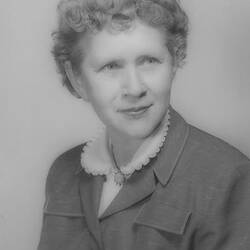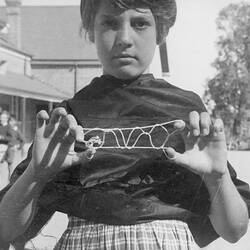Summary
Game names (and types): 'Murder in the Chookhouse', 'Gin' (unknown types), 'Quondongs', 'Conquerors', 'Conkers', 'Cob-nut' (play with equipment/props), 'Shears' (imitation game), 'Two-Up', 'Toodlembuck' (gambling, taw use), 'Bushrangers and Miners', 'Goodies and Baddies', 'Australian Dingo', 'Prisoners Base', 'Police and Robbers' (imaginary play), 'Tiggy', 'Kangaroo Hop' (chasing games), 'Snail Hoppy', 'Hoppy', 'Kangaroo Hop', 'Spider Web' (Hopscotch), 'Eenie, Meenie, Minie, Moe', 'One potato, two potato, three potato, four' (counting-out games), 'Puss in the Corner', 'Rounders' (ball games), 'Botany Bay' (language games), Knucklebones, Jacks (knucklebones, taw use), 'Sydney Harbour Bridge' (string games), 'Kookaburro', 'Skinning the cat', 'Crack-the-Whip' (miscellaneous physical play), 'Roses are Red', (autograph custom albums), Marbles (marbles), 'British Bulldog' (chasing game), 'Red Rover' (ball game)
Alternative game types: play with equipment/props, dramatic play, choosing games, running games, chasing games, bat and ball games
Article titled 'Folklore of Australian Children' written by Dr Dorothy Howard and published in the Fall Issue of Keystone Folklore Quarterly in 1965. Dr Howard read the paper before the Pennsylvania Folklore Society in Pittsburgh in May 1965 and thus, it provides highlights from Australian field trip as well as discussions of the universal issues affecting children's play. She begins by describing the reasons for her Australian field trip, citing a curiosity to learn about children's games and play customs in other English speaking countries as her primary motivation. Dr Howard briefly lists the field trip's challenges before discussing the concept of folklore as a process, which changes, adapts or dies. In the case of Australian children, she considers the various factors influencing types of play such as history, climate, economy, topography, flora and fauna, Indigenous children's games, and the role of imagination. Dr Howard proceeds to describe the historical origins and symbolism of uniquely Australian children's games including 'Bushrangers and Miners', 'Prisoners Base', 'Shears', 'Toodlembuck', 'Quondongs', 'Kangaroo Hop', and 'Kookaburro' (sic). She also considers the influence of the games and play customs of Indigenous Australian children on the wider community. She highlights the hopscotch games 'Snail Hoppy' and 'Spider Web' demonstrated by Poppy ?, a student at a government school for Aboriginal children in Sydney and further elucidated by the school's headmaster Mr Williams. Dr Howard concludes with reflections on the growing trends of the standardisation and professionalisation of children's games, the urbanisation of playing environments and the increased supervision of children's play.
One of a collection of publications about children's folklore written by Dr Dorothy Howard. Dr Howard came to Australia in 1954-55 as an American Fulbright scholar to study Australian children's folklore. She travelled across Australia for 10 months collecting children's playground rhymes, games, play artefacts, etc. The original fieldwork she collected during this period is held in the Australian Children's Folklore Collection (ACFC) at Museum Victoria and includes index cards, letters and photographs.
Physical Description
Article with typed black text printed on paper. Nine, unbound pages printed on both sides. Handwritten annotation in black ink on first page.
More Information
-
Collection Names
Australian Children's Folklore Collection, Dorothy Howard Collection
-
Collecting Areas
-
Acquisition Information
Cultural Gifts Donation from Dr June Factor, 18 May 1999
-
Acknowledgement
Donated through the Australian Government's Cultural Gifts Program.
-
Collector
-
Author
-
Publisher
Keystone Folklore Quarterly, Pennsylvania, United States of America, 1965
-
Person Named
Dr Brian Sutton-Smith, New Zealand, circa 1959
Dr. Howard cites Sutton-Smith's investigation of the influence of Maori children's games on those played by non-Indigenous New Zealand children, circa 1959. -
Person Named
Iona and Peter Opie, England, Great Britain, circa 1959
Dr. Howard cites Iona and Peter Opie's research of the lore and language of school children, circa 1959. -
Classification
-
Category
-
Discipline
-
Type of item
-
Overall Dimensions
137 mm (Width), 228 mm (Height)
Orientation: portrait
-
Keywords



